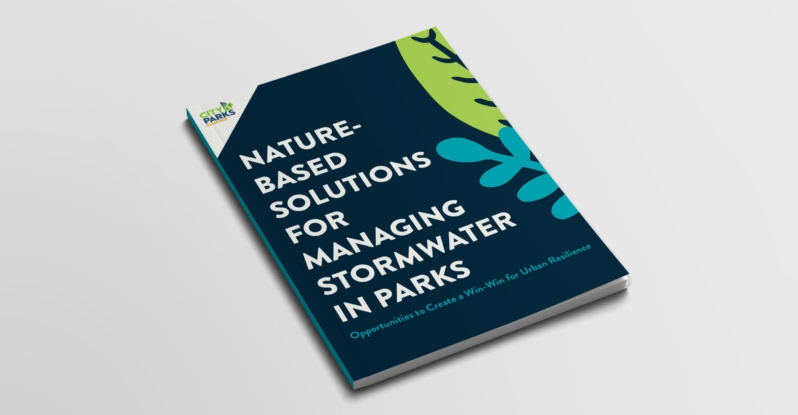Summary
In 2016, San Francisco voters approved Proposition B, a park revenue measure that included a requirement to develop an equity analysis. The driving force to pass Proposition B was San Francisco Parks Alliance, with full support from San Francisco Recreation and Parks Department (SFRPD), and endorsements from park advocates, environmental organizations, and children/family supporters. To define “low-income and disadvantaged communities,” SFRPD adopted use of a statewide open data set called CalEnviroScreen3.0, provided by the California EPA.

San Francisco, CA: Tiny Tots Swim Class at Hamilton Pool, in an equity zone, and the only pool citywide with a slide!
Overview
The San Francisco Recreation and Parks Department (SFRPD) manages more than 220 parks, playgrounds, and open spaces, including two outside the city limits. The system includes 25 recreation centers, nine swimming pools, five golf courses, and hundreds of tennis courts, ball diamonds, soccer fields, and other sports venues. Included in the department’s responsibilities are the Marina Yacht Harbor, the San Francisco Zoo, and the Lake Merced complex. The SFRPD employs about 1,300 people, from gardeners, foresters, and recreation leaders to park rangers, custodians, electricians, painters, and more. Golden Gate Park is now the third most visited park in the nation (behind Central Park and the Lincoln Memorial) with 24 million annual visitors. The department’s FY19 annual operation budget is $262 million, and it has an active capitol portfolio of approximately $300 million.
Proposition B
In 2016, San Francisco voters approved a charter amendment (Proposition B) that established a revenue baseline for park maintenance funding. The language included a requirement to develop an equity analysis and metrics to measure the allocation of “recreation and park services and resources to low-income and disadvantaged communities compared to the city as a whole.” As such, SFRPD annually collects, analyzes, and reports on a set of metrics that serve as a tool to measure equity, or parity/disparity.
Driving Force behind Initiative
The driving force to pass Proposition B was SF Parks Alliance, (SFRPD nonprofit partner) with full support from SFRPD, and endorsements from park advocates, environmental organizations, and children/family supporters. The equity language was added into Proposition B by a county supervisor, and SFRPD welcomed the opportunity to develop a measurement tool and elevate equity in funding decisions.
Site Selection Criteria
To define “low-income and disadvantaged communities,” SFRPD adopted use of a statewide open data set called CalEnviroScreen3.0, provided by the California EPA. The data is used by many California agencies to define “disadvantaged” for various programs and preferences. The EPA data is organized by census tract for the entire state. SFRPD used eight of the indicators for disadvantage and added two more they believed were particularly relevant for San Francisco (non-white) and age (prevalence of youth and seniors).
In total, there are 10 characteristics equally weighted and accumulated (summed) by census track. The census tracts are then ranked. Those with the 20% highest rate of disadvantaged characteristics were designated “Equity Zones.” A five-minute buffer was added, then an imaginary line was drawn around on the map, thereby allowing the department to identify parks within the Equity Zones. From there, staff evaluated the services and resources within Equity Zones compared to the city as a whole using these metrics:
- Park access – Number of parks and park acres per person
- Safety – San Francisco Police Department number of incidents
- Maintenance – Maintenance and repair requests completed
- Capital Investment – Dollars budgeted at the site level
- Volunteers – Hours of volunteer service
- Recreation – Hours of recreational programming
How to Keep the Program Running
The charter amendment requires SFRPD to measure and report on equity annually for 30 years, and there is growing interest among other city departments to provide the same analysis and/or to coordinate a citywide evaluation. Public resources form an ecosystem of government services and using the same lens to look at the system would provide the most accurate view of overall resource distribution.
Tracking the Progress of the Initiative
Department staff self-report to their commission (Recreation and Parks Commission), publish on their website, and include the equity metrics in the annual update to the strategic plan, operational plan, and capital plan. The city controller initially validated the mathematical and GIS-computations and must certify the department meets the requirement every four years.
Key Ingredients to Making Equitable Park Funding a Success
SFRPD is continuing to gather feedback from park advocates, sister departments, and elected officials to make the methodology, data, and metrics more meaningful and refined. They have completed a project to ground truth the data by visiting parks in equity zones and now have more than 700 intercept surveys of park visitors and residents who do not visit the park to better understand why, and what barriers are within the department’s control.
Obstacles to Implementing Equity Park Funding
SFRPD staff are stewards of more than 220 parks, which are all available to all residents and visitors. Designating specific, set aside funds for certain neighborhoods or parks does not serve this broad mission. Also, there is a persistent belief that funding is zero-sum; if we prioritize parks in disadvantaged communities then parks in other communities will get less funding than they do now. Economic inequality is a central issue in San Francisco, and the public is aware of the city’s intentional management of this complex issue. Public investment leads to private investment, which can lead to gentrification, and residents of Equity Zones often have conflicting and skeptical perceptions of increased park investment.
Can this model be replicated?
Other cities in California could the same data set and replicate the methodology for defining disadvantaged communities.
To reference this material, please cite Equitable Parks: Case Studies + Recommendations, City Parks Alliance, 2020.
Equitable Park Funding Research & Strategies
This case study is one of seven, compiled as part of City Parks Alliance’s national initiative to research, curate, and disseminate innovative strategies and models for funding parks and green infrastructure in low-income communities.



